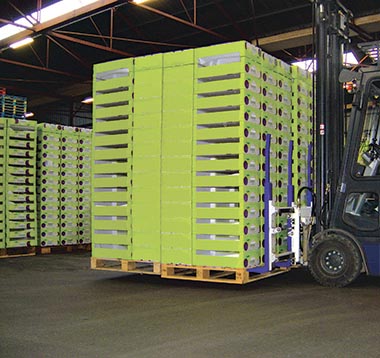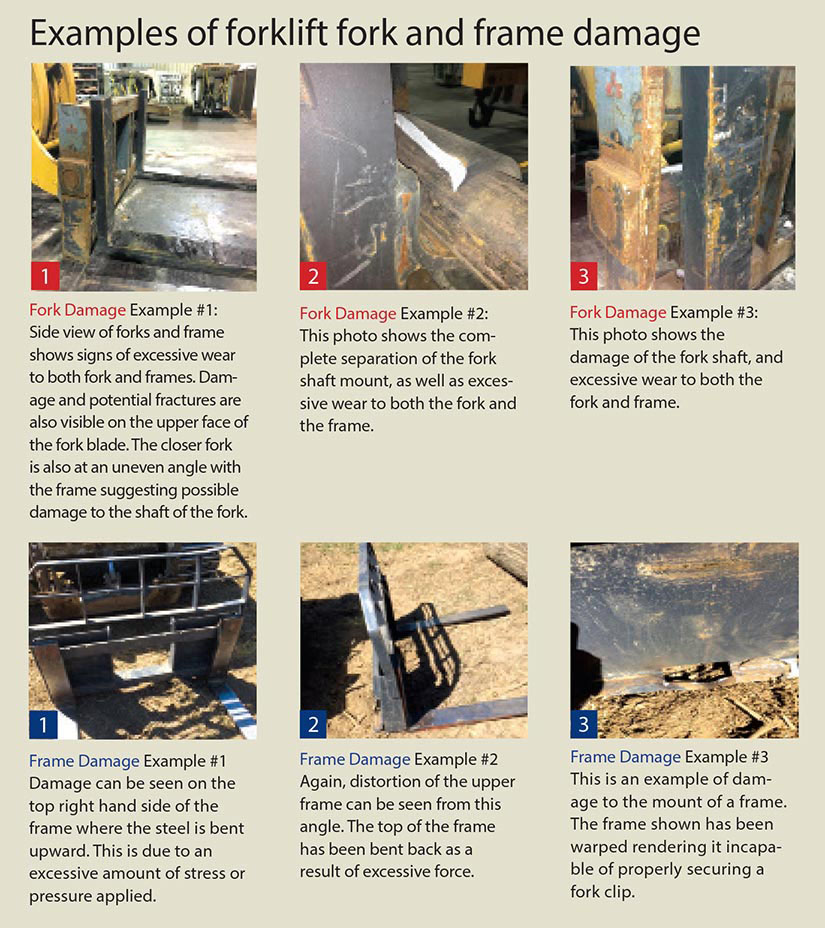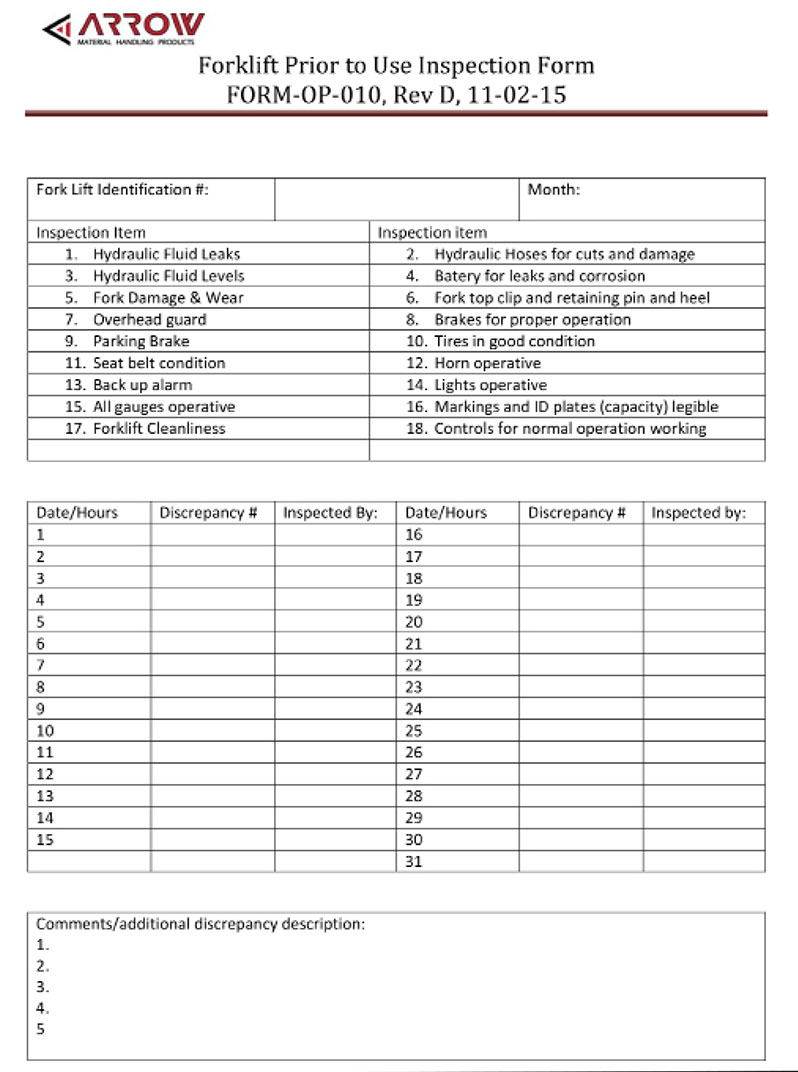The Power of Good Lift Truck Attachment Maintenance
Ensuring all your lift truck attachments, including forks, are in good working order pays productivity and safety dividends to your operations.

This may be an uncomfortable question, but it’s got to be asked: When was the last time you visually inspected your lift truck attachments for wear and damage?
Attachments here include everything from side shifters and carton clamps to drum handlers and forks.
The experts say attachments should be inspected daily. After all, who except the individual operator knows what kind of abuse the attachments were subjected to yesterday? Probably no one. But even though attachments are designed to take abuse, they can’t be expected to hold up to all extremes. And, there’s also expected wear from use.
“A lot of the time, attachment maintenance is more a matter of checking than actually having to do something before the equipment can be used again,” says Clark Jordan, vice president of global engineering at Cascade. “Keeping maintenance as simple and easy as possible is a good goal,” Jordan adds.
But there’s more to lift truck attachment maintenance than just wear and tear. “If you’re more proactive about maintenance, your productivity and safety will directly benefit,” explains Darren Berg, president of drum handler supplier Liftomatic.
Regular attention to maintenance minimizes downtime and extends the longevity of the equipment, adds Cascade’s service manager Steve Dalton. And, it doesn’t necessarily take a lot of time. Just a few minutes a day is adequate.

Visual inspection of forks easily identifies deficiencies from surface cracks to fork blade wear. |
On the safety side, it’s critical to pay attention to wear of forks, for instance. According to industry standards, just 10% of fork wear reduces lift truck rated capacity by 20%. That’s an issue especially if your operations continually move loads that are at or near the top capacity for your lift trucks. Beyond wear, other safety issues include stress cracks and damaged welds, to name two concerns across all types of attachments.
Then, there are maintenance costs. Suppliers generally agree that the most effective way to keep these at a minimum is to perform daily inspections and follow the maintenance schedules in operation manuals.
Start with forks
“About 30% of all forks inspected fail to meet safety standards,” reports Terry Melvin, CEO of Arrow Material Handling Products. “It helps everyone if we can provide a safe environment.”
There are several conditions that qualify here, according to OSHA.
- surface cracks
- blade or shank not straight,
- fork angle from blade to shank is not straight,
- difference in height of fork tips,
- positioning lock not in working order,
- fork blade or shank wear,
- fork hooks wear, and
- fork marking not legible.
You can access the OSHA Website on forks here.
Fork heels are especially worth inspecting. They take all the stresses of lifting loads at various heights and are a crucial element to maintaining lift truck capacity ratings. Forks should have a 90-degree angle between the shank and the blade. If that is not the case, the fork needs to be replaced.
Difference in the height of fork blade tips is critical, too. “The difference in the tip height should stay within 3% of the length of the fork blade, says Melvin.

Fork wear is one of the more common maintenance issues and worth special consideration due to the de-rating implications. Standard industry practice is to use a fork caliper to measure wear. But in the better mousetrap category is a patented forklift wear indicator just being released by Arrow.
The indicator provides a colorful visual reference on the side of each fork to indicate degree of wear. On the indicator, green indicates the fork is safe, yellow shows it is approaching end of service, and red declares the fork is unsafe for future use.
Melvin says there are several advantages to the new indicator, including a simple, quick visual inspection of wear, reduced inspection time, increased accuracy, as well as reduced possibility for human error.
Then there is the issue of fork replacement. Forks should always be replaced in pairs, says Melvin. Two forks with different wear and usage is a cause for safety concern. “Replacing just one fork may seem like a good idea, but can actually lead to serious safety violations,” he adds.
Maintenance of other attachments
Following scheduled maintenance lists in manuals for all types of attachments is good standard practice, says Cascade’s Dalton. Often, drivers can spot problems and techs can take care of them in short order.
It is also worth noting that rental fleets typically have maintenance schedules built into contracts. In the majority of these cases, maintenance rests with the dealer.
Beyond daily visual inspections, this often includes scheduled maintenance at specific hours of use—100, 500, 1,000, 2,000 and even 4,000 hours. As Liftomatic’s Berg points out, attachment maintenance schedules aren’t a whole lot different than maintaining your car at certain mileage milestones.
For instance, Cascade’s carton clamp manual identifies specific actions at those hourly intervals. The maintenance required at each stage differs from that at other stages, and the detailed list in the manual should be followed.

A patented forklift wear indicator painted on the fork itself shows the degree of wear at each point in the lifetime use of the equipment.
At 100 hours, check for loose or missing bolts, damaged hoses and hydraulic leaks. This is also the time to check the torque on capscrews and grind down any rough edges on contact pads.
The list gets longer at 500 hours. This is a key time to check for wear on bushings and pads as well as cracks on welds. Lubrication of several parts is important at this point, too.
For the 1,000-, 2,000- and 4,000-hour maintenance checks, it is recommended to repeat the 100- and 500-hour maintenance checks and add one or two additional inspections.
Drum handlers require their own specific maintenance, explains engineer Pete Mangovski at Morse. These tasks include lubricating the cylinder clevises in the drum-grab assembly every six months. Moving parts should be cleaned and oiled periodically. Furthermore, the hydraulic system requires attention for oil drips, hose damage and other signs of wear. A full list is included in the operator’s manual.
In addition to daily visual inspections, Berg recommends lubrication weekly and more formal inspections quarterly of drum handlers. In some cases, parts disassembly is suggested in accordance with Liftomatic recommendations. Also available are preventative maintenance kits and a complete refurbishment service.
All too often, lift truck attachment maintenance has had a punitive HR aspect to it, says Arrow’s Melvin. “You know, catch someone who is doing something wrong.” But as he points out, the approach should be to keep people safe and as productive as possible. Do that and your lift truck attachments will last a long time.
Example of a Forklift Prior to Use Inspection Form

Companies mentioned in this article:

Article Topics
MRO News & Resources
Avidbots showcases autonomous cleaning robots Traka exhibits modular lockers MRO Survey: Finding and keeping the best technicians Maintenance, Repair and Operations: Understanding the true condition of the equipment Newly formed Bison combines AMETEK DFS and Bison Gear and Engineering Corp. Building (and maintaining) your maintenance, repair and operations (MRO) tech workforce The power side of lift truck battery and charger maintenance More MROLatest in Materials Handling
NetLogistik partners with Vuzix subsidiary Moviynt to offer mobility solutions for warehouses Materials Handling Robotics: The new world of heterogeneous robotic integration Lucas Watson appointed CSO for Körber’s Parcel Logistics business in North America Hyster recognizes Dealers of Distinction for 2023 Carolina Handling names Joe Perkins as COO C-suite Interview with Keith Moore, CEO, AutoScheduler.AI: MODEX was a meeting place for innovation Walmart deploying autonomous lift trucks at four of its high-tech DCs More Materials HandlingSubscribe to Materials Handling Magazine

Find out what the world's most innovative companies are doing to improve productivity in their plants and distribution centers.
Start your FREE subscription today.
April 2024 Modern Materials Handling

Latest Resources










